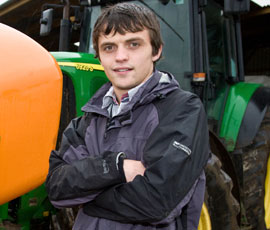Finding my sea legs after a lengthy harvest

Finding my sea legs after a lengthy harvestIt’s not often that we are harvesting wheat in July in this part of the world, though equally I don’t ever remember the combine still rolling much into September either.
I think that just about sums up this cropping year. From one of the coldest winters to the warmest April, driest spring and coolest summer in living memory, comes certainly the longest pea-vining season and an especially long wheat harvest too.
As I write, we’ve just polished off the last of the spring wheat on our own farm, but there’s still three good days left for the combine on our neighbour’s. Though the weather in South Lincolnshire hasn’t been what I’d describe as atrocious this August, there have been enough regular showers to make harvest a very much “stop-start” affair.
As mentioned in my last column, yields have continued to be highly variable with second wheats seeming to have borne the brunt of the spring drought far more than firsts. That said, though yields have been lower than average, they certainly have not been disastrous considering that we only grow Group 1 and 2 wheat varieties.
Having just got the sample results in the post too, it’s been good to see that the high input costs attached to these varieties have paid off with everything in the barn attracting a protein premium – actually quite unusual on our soil types.
Though the combine hasn’t been rolling all that much, what has been moving apace is the land work. The cold winter and dry spring have combined to create some of the best seed-beds straight off the plough that I’ve ever seen, and our intentions to min-till some of the heavier land this year were quite quickly thrown overboard.
Though ploughing is an expensive method of establishment, it seems silly to abandon a sterile seed-bed in a year when achieving one is much easier than normal.
Spending the working day in a tractor cab does have its disadvantages. I’ve now completed what has become an annual tradition of breaking a thermos flask by letting it roll under my seat and then bouncing up and down on top of it as I drive over some wheelings.
Plus, the Paramore album that has been stuck in my CD player for three years is – I’m ashamed to say – beginning to grate on me. I’ve been forced to listen to either the local community station Tulip Radio, or (shock horror) Radio 4. Does this make me an old man?
Back in the yard, and in the course of saving some of our own seed for the first time, we’ve also discovered that an old eight-tonne trailer actually holds eleven. This might not have come as a surprise to the 30-year old 65hp John Deere that has been pulling it round the yard though, and which made quite a big deal of tipping it up.
Though this summer has been ridiculously busy, a couple of days of drizzle has enabled me to join the extended family on holiday at the coast for a quick break.
My mum’s side of the family has always been into sailing and I’ve been bitten by the bug too, although please don’t imagine an elaborate gathering of super-yachts. I’d describe the family’s handful of dinghies as more of a motley crew than a prize-winning fleet, typified by my boat, which was bought some years ago for the grand sum of £60.
You may or may not know that changing a boat’s name is considered very unlucky and because we buy all of ours second hand, we’ve inherited some pretty awful names. For example, my brother’s was originally imported from Belgium and is called “Europhiel”, which sounds like the sort of seedy club where some of our Brussels-based MPs would be regular patrons.
My grandfather decided to increase our family’s flotilla with a sailing boat that was advertised on a shop noticeboard.
As it turned out, some of the woodwork was well past its best and as we put it back on its trailer one of the two rowlocks rotted off.
A fine sea-faring vessel it is not, but at least it’s in good company with the rest of the collection.
COLMN
